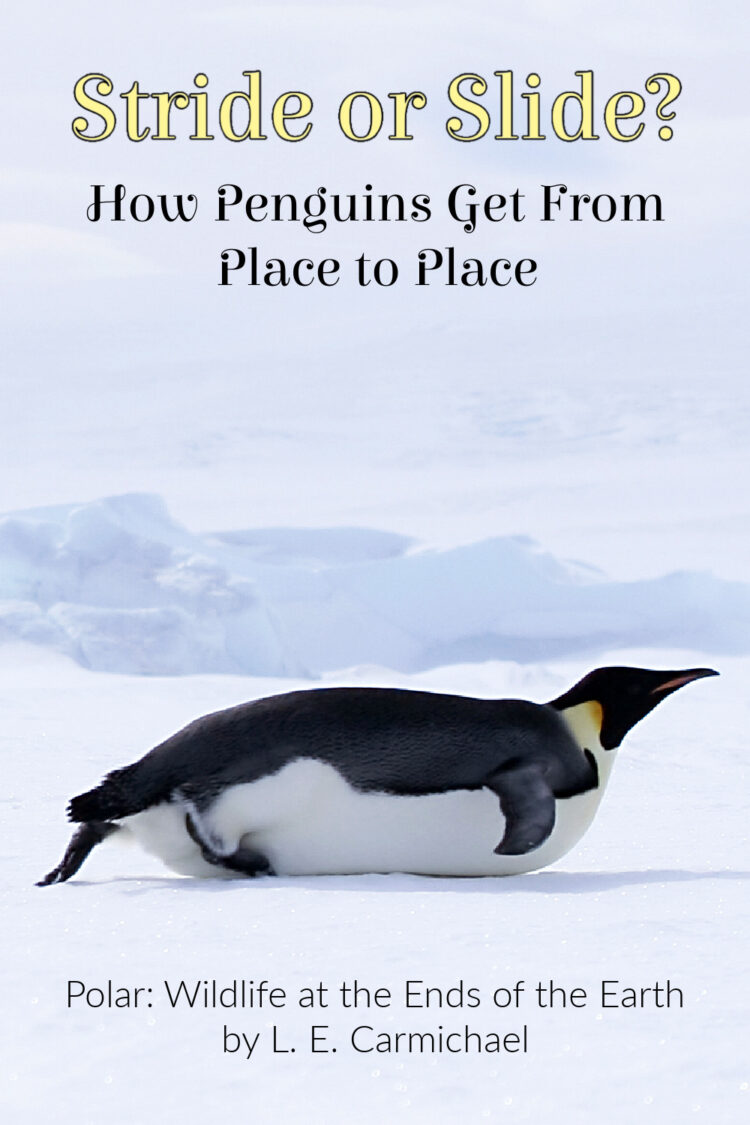 It’s World Penguin Day! According to Penguins International, there are 18 species of penguins worldwide, three of which appear in Polar: Wildlife at the Ends of the Earth:
It’s World Penguin Day! According to Penguins International, there are 18 species of penguins worldwide, three of which appear in Polar: Wildlife at the Ends of the Earth:
- emperor penguins
- Adélie penguins, and
- chinstrap penguins
Polar is a book about the adaptations that help penguins (and other animals!) survive in Antarctic habitats. That meant I had to focus on showing the adaptation at work in the wild… which meant that I couldn’t talk about some of the mind-boggling ways that scientists have studied these adaptations.
Until now.
Two of the most eye-popping experiments I came across related to penguin movement patterns. Specifically:
- how much energy does a penguin use to walk?
- how much energy does a penguin use when tobogganing on its belly?
- how do snow and ice conditions influence which style of movement a penguin chooses?
Snow and ice conditions, it turns out, have a big effect on the amount of energy penguins burn just getting around. Adult Adélie penguins weigh about 5 kg. Each foot is about 255 cm square, but their bellies are about 1800 cm square. Dividing weight by area tells us that foot load is around 19.6 g / square cm, but “belly load” is only 2.8 g / square cm.
In other words, if the snow is soft, a walking penguin’s feet will sink in deep, and it will have to expend extra energy pulling its feet out before taking each step. A tobogganing penguin won’t sink as deep, and will use less energy pushing itself forward – especially on a downward slope where gravity lends a flipper!
The amount of friction between the penguin’s belly feathers and the sliding surface also affects the amount of energy it burns while sliding: a slick surface like smooth ice offers less resistance than uneven or coarse surfaces. How did scientists measure that friction? The experiment was more eyebrow-raising than eye-popping. They sedated a penguin, tied a string to its beak, and pulled it forwards. Once they confirmed that a “freshly killed” penguin gave the same results, they dragged a dead bird both forwards and backwards across the snow.
That was in the early 1990s, and – thank goodness! – the ethics governing animal experiments have evolved considerably since then. I can’t imagine scientists getting permission to perform such an experiment today. But those old-school biologists did manage to prove that friction going backwards is much higher than friction going forwards, which means that, when penguins toboggan uphill, their belly feathers act like tiny little crampons, digging into the surface and helping to prevent them from sliding back down to the sea. So that’s something, I guess?
The second experiment I discovered contains much less ickiness. In fact, it’s entirely delightful.
Like a lot of critters that spend most of their time in the water, penguins have a streamlined shape. Their legs are short and set far back under their bodies, which helps reduce drag in the water. When walking, however, those short, rear-positioned legs produce a whole lot of “lateral displacement,” meaning the penguin has to swing its body from side to side just to get its feet going forward. Compared to similar-sized birds with longer legs, this takes a whole lot of energy.
To figure out just how much energy penguins were burning, Dr. Berry Pinshow and his team measured their metabolic rate by measuring how much oxygen their bodies were consuming. To do that, they trained penguins to walk on treadmills while wearing gas masks that captured their breaths.
And we will now pause for a moment to appreciate the sheer awesomeness of that mental image:
PENGUINS. On TREADMILLS. Wearing GAS MASKS.
You’re welcome.
Pinshow’s team determined that top walking speed for an emperor penguin is about 2.8 km per hour, which required an average of 85 steps per minute. In comparison, rheas – birds with the same body mass but longer legs – only had to take 50 strides per minute at that speed. If the math is confusing, remember what it was like when you were a kid, trying to keep up with a parent in the supermarket – you (the penguin) had to take a lot more steps than your grown up (the rhea) to cover the same distance in the same amount of time.
Which means penguins burn more energy walking than birds that have evolved to spend more time on land. No wonder penguins often choose to toboggan – it takes a lot less energy! And if your breeding colony is 300 km from the place where you get your food, every calorie counts.
Teachers! Do you want your students to see pictures of penguins on treadmills? Because I’ve got them, and they are flat-out AMAZEBALLS. Contact me to schedule a school visit.
Seven more sleeps until Polar arrives. Pre-order your copy from your local indie or your favourite online retailer. And don’t forget to check my Public Appearances page for Polar virtual events and live events happening near you!